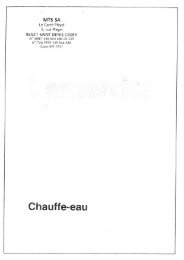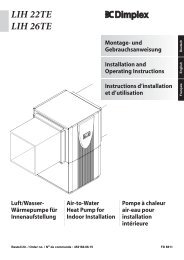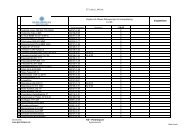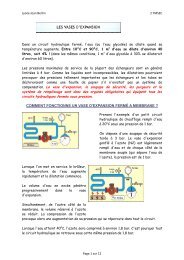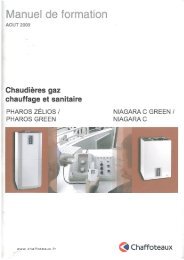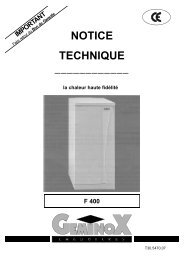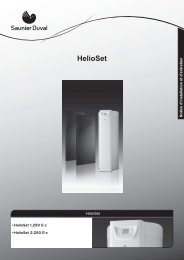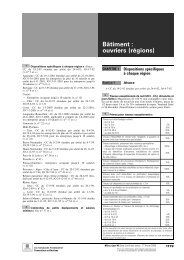MANUALE PER L'INSTALLAZIONE - enrdd.com
MANUALE PER L'INSTALLAZIONE - enrdd.com
MANUALE PER L'INSTALLAZIONE - enrdd.com
Create successful ePaper yourself
Turn your PDF publications into a flip-book with our unique Google optimized e-Paper software.
2.10 Refrigerant recovery<br />
Procedure for returning all the refrigerant to the external unit.<br />
1. unscrew the caps from the cocks on the two-way and three-way valves.<br />
2. set the appliance to cooling mode (check whether the <strong>com</strong>pressor works) and leave the<br />
appliance on for a few minutes.<br />
3. connect the pressure gauge.<br />
4. close the two-way valve.<br />
5. when the pressure gauge reads “0”, close the three-way valve and turn the air conditioning<br />
off immediately.<br />
6. shut the caps on the valves.<br />
MODEL<br />
Liquid pipe diameter<br />
Gas pipe diameter<br />
Maximum length of pipe with standard charge<br />
Maximum distance between internal and external unit*<br />
Extra gas recharge<br />
Maximum difference in height between int. and ext. unit**<br />
Type of refrigerant<br />
(*) at the maximum distance, the efficiency is approximately 90%.<br />
(**) with a difference in height of more than 3 m, we re<strong>com</strong>mend you include a trap as illustrated in the figure.<br />
27<br />
ATTENTION:<br />
Recharge any refrigerant gas in accordance with the instructions provided on the product<br />
used, wearing protective clothing, avoiding violent outlets of gas from the tank or from the<br />
system’s connections.<br />
IMPORTANT CHECK FOR ANY REFRIGERANT LEAKS<br />
Once you have made the connections, open the cocks so that the gas fills the piping and<br />
always check all piping against leaks using a leak detector. (personal injury from cold burns)<br />
2.11 Charging the refrigerant gas<br />
7000-9000 12000 18000 (9000+12000) 24000<br />
(2x9000)<br />
1/4” 1/4” 1/4” 1/4” 1/4”<br />
3/8” 1/2” 1/2” 3/8” - 1/2” 1/2”<br />
5m 4 m 4m 4m 4m<br />
10m - (2x20m) 20 m 15m 2x20m 20m<br />
20 g/m 20 g/m 20 g/m 20g/m - 30g/m 20 g/m<br />
5m - (2x5m) 5 m 8m 10m 2x10m<br />
R410A R410A R410A R410A R410A<br />
Before proceeding with the refrigerant charging operations, check that all the valves and cocks<br />
are shut.<br />
N.B: the first time you install the appliance, perform the procedure described in paragraph<br />
2.7 “Making a vacuum and checking the tightness”.<br />
1. Connect the service valve to the low pressure connection of the pressure gauge, and connect<br />
the refrigerant tank to the central inlet of the pressure gauge. Open the refrigerant tank<br />
and then open the cap on the central valve and act on the pin valve until you hear the refrigerant<br />
exiting, then release the pin and screw the cap back on.<br />
2. Open the three-way valve and the two-way valve.<br />
3. Turn on the air conditioning unit on cooling mode. Leave it on for a few minutes.<br />
4. Control the pressure shown on the pressure gauge.<br />
5. Open the “LOW” knob and allow the refrigerant to flow gradually.<br />
6. Once the pressure level is reached, shut the “LOW” knob.<br />
7. When the charging is <strong>com</strong>plete, test the operation, measuring the temperature of the gas pipe<br />
with the special thermometer: the temperature should be between 5°C and 8°C more than<br />
the temperature read on the evaporation temperature section of the pressure gauge. Now<br />
check the stability of the pressure, connecting the pressure gauge assembly to the three-way<br />
service valve. Open the two-way and three-way valves fully, turn on the air conditioning unit<br />
and check there are no refrigerant leaks using the leak detector. (if there are any leaks, carry<br />
out the procedure described in paragraph 2.10 “refrigerant recovery”).<br />
8. Disconnect the pressure gauge from the valve and turn the air conditioning unit off.<br />
9. Disconnect the tank from the pressure gauge and close all caps.<br />
27



